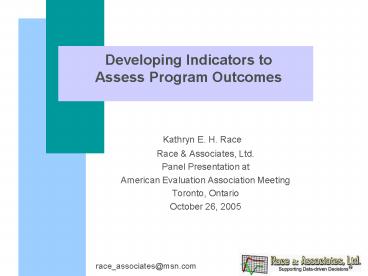Developing Indicators to Assess Program Outcomes - PowerPoint PPT Presentation
Title:
Developing Indicators to Assess Program Outcomes
Description:
Developing Indicators to Assess Program Outcomes Kathryn E. H. Race Race & Associates, Ltd. Panel Presentation at American Evaluation Association Meeting – PowerPoint PPT presentation
Number of Views:38
Avg rating:3.0/5.0
Title: Developing Indicators to Assess Program Outcomes
1
Developing Indicators to Assess Program Outcomes
- Kathryn E. H. Race
- Race Associates, Ltd.
- Panel Presentation at
- American Evaluation Association Meeting
- Toronto, Ontario
- October 26, 2005
- race_associates_at_msn.com
2
Two Broad Perspectives
- 1. Measuring the Model
- 2. Measuring Program Outcomes
3
Measuring the Program Model
- What metrics can be used to assess program
strategies or other model components? - How can these metrics be used in outcomes
assessment?
4
Measuring ProgramStrategies or Components
- Examples Use of rubric(s), triangulated data
from program staff/target audience
5
At the Program Level
- How does the program vary when implemented? --
across site - What strategies were implemented at full
strength? (dosing - program level) - Aid in defining core strategies how much
variation is acceptable?
6
At the Participant Level
- Use attendance data to measure strength of
intervention (Dosing - participant level) - Serve to establish basic minimum for
participation - Theoretical - Establish threshold for change to
occur
7
Measuring Program Outcomes Indicators
- Where Do You Look?
- Established instruments
- Specifically designed measures tailored to the
particular program - Suggestions from the literature
- Or in some combination of these
8
Potential Indicators
- Observations
- Existing Records
- Responses to Interviews
- Rossi, Lipsey Freeman (2004)
- Surveys
- Standardized Tests
- Physical Measurement
9
Potential Indicators
- In simplest form
- Knowledge
- Attitude/Affect
- Behavior (or behavior potential)
10
What Properties Should an Indicator Have?
- Reliability
- Validity
- Sensitivity
- Relevance
- Adequacy
- Multiple Measures
11
Reliability Consistencyof Measurement
- Internal Reliability (Cronbachs alpha)
- Test-retest
- Inter-rater
- Inter-incident
12
Reliability Relevant Questions
- If Existing Measure
- Can reliability estimates generalize to the
population in question? - Use the measure as intended?
13
Reliability Relevant Questions
- If New Measure
- Can its reliability be established or measured?
14
Validity Measure WhatsIntended
- If existing measures is there any measure of its
validity? - General patterns of behavior -- similar findings
from similar measures (convergence validity)
15
Validity
- Dissimilar findings when measures are expected to
measure different concepts or phenomenon - General patterns of behavior or stable results
16
Sensitivity Ability to Detect a Change
- Is the measure able to detect a change (if there
is a real change)? - Is the magnitude of expected change measurable?
17
Relevance Indicators Relevant to the Program
- Engage stakeholders
- Establish beforehand -- avoid/reduce counter
arguments if results are not in expected direction
18
Adequacy
- Are we measuring whats important, of priority?
- What are we measuring only partially and what are
we measuring more completely? - What are the measurement gaps?
- Not just the easy stuff
19
All These PropertiesPlus ..
- Use of Multiple Measures
20
Use of Multiple Measures
- No one measure will be enough
- Many measures, diverse in concept or drawing from
different audiences - Can compensate for under-representing outcomes
- Builds credibility
21
In Outcomes Analysis
- Results from indicators presented in
context - Of the program
- Level of intervention
- Known mediating factors
- Moderating factors in the environment
22
In Outcomes Analysis(cont.)
- Use program model assessment in outcomes
analysis - At the participant level
- At the program level
23
In Outcomes Analysis(cont.)
- Help gauge the strength of program
intervention with measured variations in program
delivery.
24
In Outcomes Analysis(cont.)
- Help gauge the strength of participant
exposure to the program.
25
In Outcomes Analysis(cont.)
- Links to strength of intervention (program
model assessment) and magnitude of program
outcomes can become compelling evidence toward
understanding potential causal relationships
between program and outcomes.
26
Take-away Points
- Measures of program strategies/ strength of
intervention can play an important role in
outcomes assessment.
27
Take-away Points(cont.)
- Look to multiple sources to find/ create
indicators - Assess properties of indicators in use
- Seek to use multiple indicators
28
Take-away Points(cont.)
- Present results in context
- Seek to understand what is measured ..
- And what is not measured
29
Take-away Points(cont.)
- And
- Dont under-estimate the value of a little luck.
30
Developing Indicators to Assess Program Outcomes
- Kathryn E. H. Race
- Race Associates, Ltd.
- Panel Presentation at
- American Evaluation Association Meeting
- Toronto, Ontario
- October 26, 2005
- race_associates_at_msn.com

